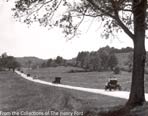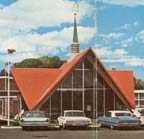
The Automobile and the Environment in American History
The Automobile's Imprint on the Landscape
There is little doubt that the widespread use of the automobile, especially after 1920, changed the rural and urban landscapes in America. It is overly simplistic to assume, however, that the automobile was the single driving force in the transformation of the countryside or the modernization of cities. In some ways automobile transport was a crucial agent for change, but in other cases it merely accelerated ongoing changes.
In several respects, the automobile made its impact felt first in rural areas where cars were used for touring and recreation on the weekends as opposed to replacing existing transit that brought people to and from work in urban areas. Some of the earliest paved roads were landscaped parkways along scenic routes. Of course, rural people were not always very pleased when urban drivers rutted unpaved roads, kicked up dust, and generally frightened or even injured livestock. Yet, cars potentially could help confront rural problems—isolation, the high cost of transporting farm products, and the labor of farm work. Although farmers may have resisted the automobile at first, by the 1920s per capita automobile ownership favored the rural family. Adoption was uneven in rural areas, however, depending on income, availability of cars, the continuing reliance on horses, and other factors. Automobile manufacturers did not lose sight of this market and courted potential customers with advertisements touting that cars were “Built for Country Roads” or promoting vehicles that would lead to “The Passing of the Horse.”
Highway construction, also irregular in rural America, nonetheless influenced rural settlement patterns. Already in the post-World War I era, one might find fringe areas on the outskirts of cities that were neither rural nor urban. Settlements along the roads might be populated with farmers, people who lived in the country but worked in the city, and service areas with a variety of roadside business catering to automobile traffic.
An array of businesses trying to catch the attention of motorists began to spring up. Crudely built shacks beckoning tourists to spend the night made way for reasonably priced tourist courts, and ultimately the ubiquitous “motel” (a term likely coined in the mid-twenties as a play on the word “hotel”). Subsequent uniformity of style and service of motels—like in the case of Holiday Inns or Howard Johnson's—provided motorists with a clear expectation of what to expect if they stopped there, and how much they were likely to pay. Florida was an early leader in building accommodations for tourists with 178 tourist courts and camps operating by the mid-1920s. Complementing the tourist court was the roadside restaurant or eating establishment. Long before the chain restaurants like McDonald’s or Denny’s there were hundreds of “mom and pop” eateries serving anything from quick meals to full-course dinners.
Most important of all were filling stations for refueling, and ultimately garages and service stations to aid the traveler suffering an untimely breakdown. In the early days of the automobile—before pumping devices were invented—travel required careful planning. Gasoline had to be obtained at “bulk depots.” These were located outside of the cities and the fuel was provided in cans or other containers. (Later gasoline for sale to motorists was transported in horsedrawn tank trucks by wholesalers to commercial customers in towns.) Sometimes the distances between the depots were too great for some motorcars, and a long walk or the help of a tow was necessary from a friendly soul with a horse. In 1905 the Automobile Gasoline Company in St. Louis employed a gravity-fed tank for fueling cars and opened the first “gas station.”
As automobile sales increased, the demand for fuel led to a more systematic way of delivery, and in 1914 Standard Oil of California opened a chain of 34 standardized stations along the West Coast. Soon gasoline pumps were being installed not only at the new service stations, but in front of hardware stores, feed companies, livery stables, and a variety of other retailers. Curbside pumping, although common in cities, was less common in the countryside, where filling stations developed. Like early tourist camps, the first service stations could be converted barns, stables, or warehouses—a far cry from the multi-purpose facilities of today. Ultimately they came in a variety of designs—from the mundane to the ultramodern—literally creating an automobile-oriented landscape quite unique from what had come before. Outdoor advertising, especially the billboard, followed the roads into the countryside and hawked all manner of products and services, including the new roadside businesses themselves. As one architectural historian noted: “Speed blurs details, signs have to be big and bright.” Automobile commercialism, not aesthetics or tastefulness, was the prime characteristic of the new advertising form. In the early 1930s, a survey was conducted along 47 miles of highway between Newark and Trenton, New Jersey. That stretch of highway included 300 gas stations, 472 billboards, and an additional 440 commercial uses. As much as creating changes in the rural landscape, the new roadside businesses had a major commercial impact beyond what anyone could have imagined.
Modern American cities also bear the imprint of automobiles and other motorized vehicles. In some cases, more than fifty percent of the ground area in the central business district of a city by the early 1960s was devoted to streets and parking spaces. While other forms of transportation before the automobile sometimes required even more street space, recent street and parking data often do not include the space necessary for businesses or services devoted in whole or in part to the automobile, such as gas and service stations, automobile dealerships, and automotive supply stores.
The “rise of the automobile city” or the retrofitting of cities to accommodate motorized vehicles must be understood within a rather broad historical context to be truly meaningful. As one social scientist has pointed out, “The majority of cities and towns have had the bulk of their urban fabric determined over many generations.” There has been congestion in central cities due to pedestrians, horses, carriages, bicycles, and streetcars. Saying this does not dismiss the quite unique and profound physical impact of the automobile. It only reconfirms that it is not the only technology that has helped to make or remake cities. Yet, since World War II in particular, it is difficult to visualize cities, their suburbs, and the urban hinterland in the United States devoid of the car.
When we think about busy city life in the twentieth century, we inevitably think about traffic and congestion. While automobiles did not invent traffic snarls, they did create new problems in cities, especially with the glut of mass-produced automobiles. Cars and trucks occupy greater street area per capita than mass transit. The large numbers of cars and the myriad trips in those cars to and from home, work, places of recreation, grocery stores, and so forth made traffic a universal subject of discussion throughout the country. Inner-city traffic also raised frustrations over parking—not only about the availability and location of spaces, but also about increased congestion and the competition for land to develop. Individual motorists, merchants, property owners, commercial fleets, taxis, and mass transit all have a need and responsibility for adequate parking. Congestion problems in core cities and across metropolitan areas in the U.S. have worsened in many places rather than improved, with motor-vehicle use doubling between 1970 and 1990.
Congestion problems were a major reason for developing some type of traffic control, and, by the mid-twentieth century, extensive highway construction. Prior to 1903 there were no rules for driving in American cities, but traffic controls of some type began to appear after the introduction of mass-produced cars. Initially controls emphasized the behavior of motorists, pedestrians, and the police. Cleveland had the first permanent installation of a red and green traffic control light in 1914; Detroit added a yellow caution light in 1917. However, getting accustomed to the new signs proved difficult for drivers used to having their own way on the road. In several cases, more experience with traffic problems led to better utilization of the streets and traffic patterns, but the rising use of the automobile created new traffic and safety practices.
One of the truisms about problems of motorized vehicle congestion was that building streets failed to keep pace with traffic demands. The solution, however, was often more roads and highways. This process of increasing hard-surface streets began in the late-nineteenth century to serve the needs of bicycle-, wagon-, and carriage-transportation, and continued into the twentieth century, primarily serving the needs of automobiles. The use of the streets as gathering places was threatened and then superseded by the needs and priorities of vehicular traffic. The Bronx River Parkway in New York City became the first highway to be designed exclusively for the use of cars (completed in 1906, but only fully opened for traffic in 1924). In newer communities, pedestrian street activity sometimes was transferred to pedestrian precincts and paths or to shopping centers and malls.
The accommodation to the automobile through a remaking of the road system and the city in general came with a price, as had the introduction of the railroad and the streetcar before it. Building new roads and highways within cities damaged human and animal habitats; neighborhoods—especially those with little political clout—could be dislocated or even destroyed; and plant life and wildlife could be in endangered. Runoff from roads and highways—oil and grease, asphalt particles, rubber from tires, sand and salt from snow and ice buildup—all contribute to nonpoint pollution making its way into watercourses. Road building in general also increases runoff and limits the filtering capacity of soil. For their part, motorized vehicles proved to be a new safety risk as well as a health risk.
<<Previous Section - Next Section>>
Introduction
Environmental Cost of the Automobile Production Process
Energy Use and the Internal Combustion Engine
Auto Emissions and Air Pollution
Noise, Visual Pollution, and Derelict Cars
The Automobile's Imprint on the Landscape
Suburbanization and the Automobile
Conclusion
Complete Text Printable View
About the Project | Credits | Contact Us | Student & Teacher Resources | Site Map
©2004-2010 Automobile in American Life and Society






